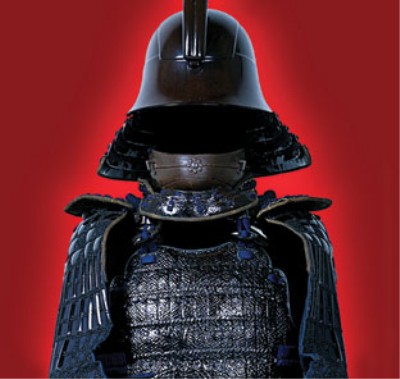 On Saturday, William and I went to the "Lords of the Samurai" exhibit at the Asian Museum of Art in SF. We were thrilled because we were able to get FREE parking not too far away from the museum and it wasn't the last week of the exhibit so it wasn't as crowded as the Afghanistan exhibit, so it was off to a much better start :-) The exhibit has several complete suits of armor of the samurai's- they initially were leather lacquered together along with intricate lacings. They later changed to European chain mail. It was a 12 step process to put on all of the pieces of their armor and it weighs 50 pounds. They even had these elaborate head pieces- one that looked like horns, another with feathers (but it wasn't allowed to come through US customs so they only have a photo of it). The exhibit also highlighted the most famous masterless samurai- also known as ronin- named Miyamoto Mushashi. Mushashi fought 68 duels throughout this life- talk about a warrior! He also wrote the classic book on military strategy and philosophy entitled "The Book of Five Rings" where there was a copy of the scroll in the exhibit. He was a master swordsman and founded the Niten Ichi school where he used both a long and a short sword together. The exhibit also contained beautiful samurai swords. We wished that we had watched this NOVA film called "Secrets of the Samurai Sword" about making samurai swords before seeing the exhibit- but right after was still good. This film shows the incredible 6 month process that it takes to make a samurai sword. The build a clay kiln where they have to watch the temperature of the different levels of iron and carbon for 3 days or else the steel will be ruined. They then dissemble the kiln to remove the different kinds of steel. A samurai sword is made of two kinds of steel- low carbon and high carbon. The high carbon is sandwiched around the low carbon and when the temperature and shape is straight, they then plunge the steel into cold water. The steel then curves naturally due to the greater contraction of the low carbon steel. We had thought that they shaped the swords to be curved- not that it was a natural process. They then buff and polish the swords. And this is why these swords could cut through up to 4 people at one time with a single slice.
On Saturday, William and I went to the "Lords of the Samurai" exhibit at the Asian Museum of Art in SF. We were thrilled because we were able to get FREE parking not too far away from the museum and it wasn't the last week of the exhibit so it wasn't as crowded as the Afghanistan exhibit, so it was off to a much better start :-) The exhibit has several complete suits of armor of the samurai's- they initially were leather lacquered together along with intricate lacings. They later changed to European chain mail. It was a 12 step process to put on all of the pieces of their armor and it weighs 50 pounds. They even had these elaborate head pieces- one that looked like horns, another with feathers (but it wasn't allowed to come through US customs so they only have a photo of it). The exhibit also highlighted the most famous masterless samurai- also known as ronin- named Miyamoto Mushashi. Mushashi fought 68 duels throughout this life- talk about a warrior! He also wrote the classic book on military strategy and philosophy entitled "The Book of Five Rings" where there was a copy of the scroll in the exhibit. He was a master swordsman and founded the Niten Ichi school where he used both a long and a short sword together. The exhibit also contained beautiful samurai swords. We wished that we had watched this NOVA film called "Secrets of the Samurai Sword" about making samurai swords before seeing the exhibit- but right after was still good. This film shows the incredible 6 month process that it takes to make a samurai sword. The build a clay kiln where they have to watch the temperature of the different levels of iron and carbon for 3 days or else the steel will be ruined. They then dissemble the kiln to remove the different kinds of steel. A samurai sword is made of two kinds of steel- low carbon and high carbon. The high carbon is sandwiched around the low carbon and when the temperature and shape is straight, they then plunge the steel into cold water. The steel then curves naturally due to the greater contraction of the low carbon steel. We had thought that they shaped the swords to be curved- not that it was a natural process. They then buff and polish the swords. And this is why these swords could cut through up to 4 people at one time with a single slice.The museum has a good cafe- we had some gyoza with miso dipping sauce, chicken teriyaki, and sweet potato fries. I am particularly fond of sweet potato fries so it was great to have some since it had been awhile.
The architecture of the museum was designed by Gae Aulenti- the same architect who designed the Musee D'Orsay in Paris (the converted train station). The Asian Art Museum is housed in part of the old public library (which vaguely reminds me of the Boston Public Library) but it also contains modern glass skylights to represent the connections between the past and the present. The permanent collection is very extensive- and does not change very often. William and I went through on our last visit and briefly wandered throughout where we discovered it had not changed much.

1 comment:
I hope you know my adventurous side lives vicariously through your blog.
Post a Comment